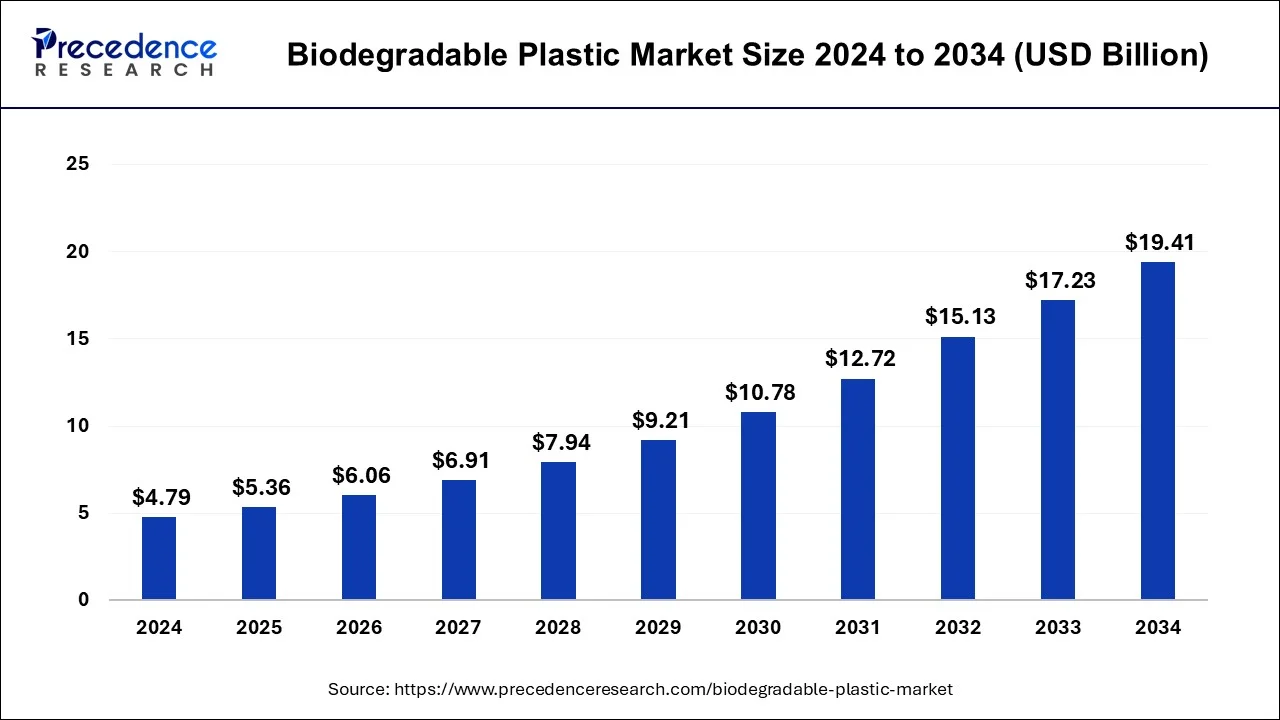The global biodegradable plastics market is expected to grow from USD 4.79 billion in 2024 to USD 19.41 billion by 2034, with a CAGR of 15.28%.

Biodegradable Plastic Market Key Takeaways
- Europe led the biodegradable plastics market with a 42.14% share in 2024.
- The Asia Pacific region is expected to grow at the fastest CAGR during the forecast period.
- The starch-based segment captured the highest market share by type in 2024.
- The Polyhydroxyalkanoate (PHA) segment is projected to expand at the fastest CAGR over the forecast period.
- The packaging segment accounted for the largest revenue share by end-use in 2024.
- The agriculture segment is anticipated to grow at the fastest CAGR between 2025 and 2034.
Market Overview
The biodegradable plastic market is growing rapidly due to increasing environmental concerns and the rising need to reduce plastic waste. Biodegradable plastics are designed to decompose naturally through the action of microorganisms, reducing environmental pollution compared to traditional plastics. These plastics are derived from renewable resources such as corn starch, sugarcane, and potato starch, making them an eco-friendly alternative. As governments across the globe implement stricter regulations to curb plastic pollution and promote sustainable practices, the demand for biodegradable plastics is expected to rise. Industries such as packaging, agriculture, consumer goods, and textiles are increasingly adopting biodegradable plastics to meet sustainability goals and comply with regulatory standards.
Drivers
Several factors are driving the growth of the biodegradable plastic market. Increasing awareness about the environmental impact of conventional plastics has led to a shift in consumer preferences toward sustainable products. Government regulations and initiatives aimed at reducing plastic waste and promoting the use of eco-friendly materials are accelerating market growth. The growing adoption of biodegradable plastics in the packaging sector, especially for food packaging and single-use items, is another key driver. Additionally, advancements in biopolymer technology and improvements in the mechanical and physical properties of biodegradable plastics are enhancing their applicability across diverse industries. The rising demand for sustainable packaging solutions from major brands and retailers is further fueling the market’s growth.
Opportunities
The biodegradable plastic market offers significant opportunities, particularly in the development of innovative materials and applications. The growing demand for sustainable alternatives in packaging, agriculture, and consumer goods presents ample growth potential for biodegradable plastics. Emerging economies, especially in Asia Pacific and Latin America, provide untapped opportunities due to increasing environmental awareness and rising government support for sustainable practices. Advancements in biopolymer technology, such as the development of biodegradable composites and blends, are expected to expand the application range of biodegradable plastics. Additionally, the increasing use of biodegradable plastics in the healthcare industry, including medical implants and drug delivery systems, offers new avenues for market growth.
Challenges
Despite its positive outlook, the biodegradable plastic market faces several challenges. High production costs compared to conventional plastics remain a significant barrier to widespread adoption. Limited infrastructure for the collection and composting of biodegradable plastics can also hinder market growth, as improper disposal may lead to ineffective biodegradation. Additionally, the lack of consumer awareness about the appropriate disposal methods for biodegradable plastics can result in contamination of recycling streams. Moreover, the mechanical and thermal properties of biodegradable plastics may not always match those of traditional plastics, limiting their use in certain applications. Addressing these challenges requires continuous innovation, public awareness campaigns, and investment in waste management infrastructure.
Regional Insights
Europe leads the biodegradable plastic market due to stringent regulations and strong government initiatives promoting sustainable practices. Countries such as Germany, France, and Italy have implemented strict bans on single-use plastics, encouraging the adoption of biodegradable alternatives. North America follows closely, driven by growing environmental awareness and increasing demand for sustainable packaging solutions.
The United States is witnessing a rise in the adoption of biodegradable plastics in industries such as food packaging, agriculture, and healthcare. The Asia Pacific region is expected to experience the fastest growth due to rising population, increasing urbanization, and growing government efforts to reduce plastic waste. Latin America and the Middle East & Africa are also emerging as potential markets, supported by improving environmental policies and increasing adoption of sustainable materials.
Recent News
The biodegradable plastic market has seen notable developments in recent years. Leading companies are focusing on expanding their product portfolios and enhancing their production capabilities to meet the growing demand for biodegradable alternatives. Advancements in biopolymer technology, such as the development of biodegradable composites and blends, are expanding the application range of these materials. Government initiatives aimed at reducing plastic waste and promoting sustainable practices are further boosting market growth. Additionally, collaborations between manufacturers and research institutions are driving innovation in biodegradable plastic formulations, enhancing their performance and applicability across various industries.
Biodegradable Plastic Market Companies
- Biome Technologies plc
- Mitsubishi Chemical Corporation
- BASF SE
- Plantic Technologies Limited
- Yield10 Bioscience, Inc.
- Corbion
- Eastman Chemical Company
- Dow Inc.
- NatureWorks LLC
Segments Covered in the Report
By Type
- Starch-based
- PBS
- PLA
- PHA
- PBAT
- Others
By End-User
- Consumer Goods
- Agriculture
- Packaging
- Others
By Geography
- North America
- Europe
- Asia-Pacific
- Latin America
- Middle East & Africa